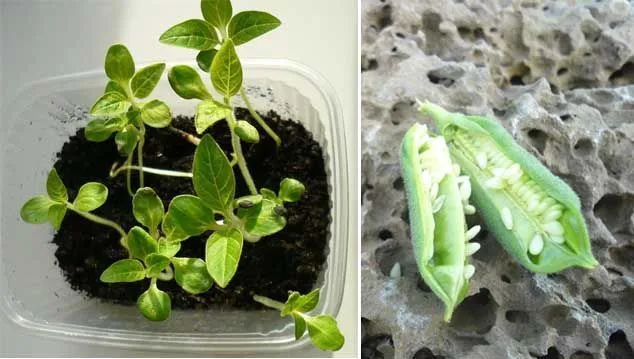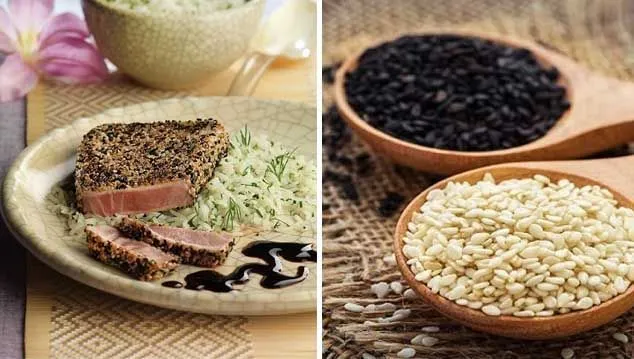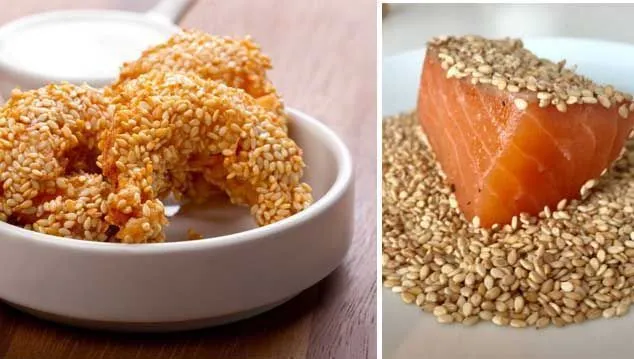The superfood craze is here to stay. Those ingredients that have a magnificent nutritional composition, low in fat and high concentration of vitamins.
Among them, we must include many seeds of historical plants, including those of chia, flax, poppy or sesame.
The properties of sesame they come from the perfect union between its nutritional composition and the chemical components present in it.
As you will see throughout the article, sesame seeds provide us with a multitude of benefits and more and more we can see them in hamburger breads, Chinese food, sushi, Middle Eastern ingredients, etc.
We will gradually discover its origin, the characteristics of the plant, its nutritional composition and the properties of sesame.
Table of Contents
The origin of sesame
Sesame and more specifically its seeds come from a plant whose scientific name is Sesamum indicum.
This plant, commonly known also as sesame, especially in the Americas, comes from Africa and India.
From there, it was transported by slaves who settled in America.
Like any other seed, its caloric content is high, since from something so small enough energy is saved to allow its germination and the development of the plant to the first roots.

Nutritional composition
The nutritional profile of this seed is very interesting. Sesame is mainly formed by unsaturated fatty acids (poly and monounsaturated), it also provides us with vegetable protein and fiber.
As for micronutrients, sesame is a source of minerals such as magnesium, phosphorus, iron, calcium, zinc, potassium. What vitamins does sesame have? Well, these tiny seeds provide us with B vitamins such as B1 or Thiamine, folate or B9 and vitamin E.
Values for 100 grams
| Composition | Quantity |
|---|---|
| Energy | 600 kcal |
| Proteins | 17.4 grams |
| Fats | 57.05 grams |
| Fibre | 3.20 grams |
As for its mineral concentration, the high concentrations of calcium (80% of the recommended daily amount), iron (182%), phosphorus (90%) and potassium (23.5%) stand out.
Vitamin content
The main concentration of vitamins is seen in vitamin B1 or thiamine, which with the intake of 100 grams we cover almost 66% of the recommended daily amount.
The second-highest concentration of vitamins in sesame is found with vitamin B2, which covers 19% of the minimum daily amount.
As for the rest of the vitamins, the concentration is quite low and must be supplied with other foods.
Mineral content
Content per 100 grams
| Minerals | Concentration | % recommended daily |
|---|---|---|
| Sodium | 11 mg | 0.7% CDR |
| Calcium | 975 mg | 81% RDA |
| Iron | 14.5 mg | 182% RDA |
| Phosphorus | 629 mg | 90% RDA |
| Magnesium | 351 mg | 88% RDA |
| Potassium | 468 mg | 23.4% CDR |
As for the mineral contribution, it offers many advantages given the values, so high in concentration it offers and low in sodium.
It stands out mainly its high contribution of iron, to fight against anemia, calcium, phosphorus and magnesium that, together with the vitamin groups it has, has a high absorption in the body.
Properties of sesame
Many of the medicinal and healing properties that we are going to discuss are not related to the nutritional composition but to the protective phytochemicals contained in sesame seeds.
Most of the fat concentration in sesame is unsaturated, considered much more beneficial than saturated ones.
On the other hand, its concentration in lecithin and phytosterols stands out among the properties of sesame.
Both compounds have direct action against different diseases and properties suffered by humans in the XXI century.
Likewise, within the properties of sesame we find other compounds such as lignan and sesamine.
- Sesame lecithin: with antioxidant and protective properties of the cardiovascular system
- Lignans: secondary metabolites of plants with antioxidant properties.
- Sesamin: substance present in sesame oil with LDL cholesterol-lowering activity.
- Sesamol: a powerful antioxidant with antifungal action (slows down the development of fungi).
Reduces bad cholesterol
Both the lecithin Sesame as different phytosterols offer direct action against the accumulation of bad cholesterol.
These compounds act by reducing the viscosity of fats, facilitating their dissolution and reducing their ability to bind to artery walls.
This food, along with the poppy seeds, constitute a medicinal benefit against the increase in bad cholesterol.
Intestinal protector

Something to highlight about the properties of sesame seeds is their moderate fiber content (we have seen it in the table above).
100 grams of sesame is equivalent to 10% of the minimum daily amount that is recommended to take of fiber.
Although other seeds, such as flax or chia contain more fiber, it also helps improve intestinal transit by incorporating vegetable fibers into our diet.
With this, we prevent possible constipation and promote the prevention of intestinal diseases.
Intervenes in the cardiovascular system
It is phytosterols and unsaturated fatty acids that act by improving the cardiovascular system indirectly.
This is achieved by reducing the accumulation of fat in the bloodstream, keeping LDL cholesterol at bay and favoring the mineral contribution that regulates our metabolism.
Prevention of anemia
One of the properties of sesame to highlight is its high contribution in iron, far above other foods that we considered as a rich source of this microelement.
The consumption of 100 grams of sesame seeds provides almost double the minimum recommended daily amount, so even in less quantity we can cover this microelement in our body.
With this, we prevent anemias and other diseases related to low iron concentration.
Maintains a strong bone structure
If you are prone to falls and fractures, it is necessary to increase the intake of macronutrients involved in bone formation, as well as vitamins that favor their absorption.
As for the properties of sesame to build a strong bone system, they come from its high contribution of calcium and magnesium, covering almost 80% of the minimum recommended amount with 100 grams of seeds.
This, together with other foods that provide vitamin C, will help us to allow a perfect absorption of these elements and to form a robust and resistant bone structure.
How to take sesame seeds

Luckily, we find different ways to enjoy the properties of sesame, with recipes that we can easily incorporate into our diet.
We are not only talking about seeds, since we can also easily find sesame oil.
Sesame vegetable milk: we can find it or manufacture it ourselves, crushing 100 grams of sesame seeds in 1 liter of water. This shake can be complemented by adding extracts of stevia, cinnamon or other spices.
As a topping in salads: we have many dishes where it is interesting to add sesame seeds, such as in salads or vegetable creams, to give a very pleasant crunchy touch to the mixture.
Sesame oil: this perfect dressing can be used in salads, meats and fish. Likewise, we find in supermarkets topical use as a moisturizing cream or oil, both for the skin and for the hair.
Tahini or tahin: This traditional Arabic paste is commonly used to prepare hummus (chickpea puree) or baba ganush (eggplant puree).
Where to buy sesame seeds
Side effects and contraindications of sesame
As always, we find some side effects or counterproductive in most medicinal plants, sprouts and seeds.
Consult with your doctor the maximum recommended amount of sesame seeds, since in high amounts they can be mildly toxic.
In small portions, such as those that we find you in different ingredients such as bread, hummus and sesame oil, it does not present contraindications.
